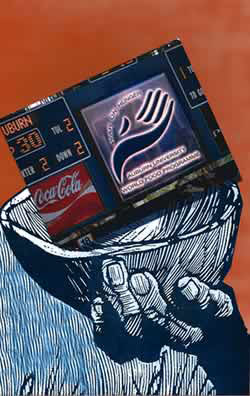College of Ag Fighting War On Hunger
By: Sally R. Credille

Last fall marked the first meeting of the College of Agriculture’s Subcommittee of 19, which is helping make plans for the 2006 War On Hunger student campaign. The United Nations World Food Programme, one of the world’s largest humanitarian agencies, selected Auburn University in 2004 to establish the worldwide model as a student-led program to increase awareness of global hunger and poverty.
“Hunger is a living world problem,” says Bill Hardy, associate CoAg dean. “It’s up to students to create objectives for the program, but public awareness and generating concern by everybody is the main goal.”
Nineteen students represent Auburn University’s 12 schools, colleges and major campus organizations in what’s called the Committee of 19. The name is symbolic of the 19 cents a day it takes the World Food Programme to feed a hungry child in a developing Third-World country. The committee is divided into subcommittees of 19 students that serve as a source of guidance and support for the Committee of 19. The College of Agriculture’s subcommittee is one such group.
“People need to realize how serious and widespread this problem of hunger is, and how easy it is for us to help,” says Christina Jacoway, a Committee of 19 member and head of the CoAg subcommittee.
Through a pre-existing relationship with the United Nations, in a joint sponsorship of the International Quality of Life Awards, Auburn University’s College of Human Sciences has led the War On Hunger campaign. The College of Agriculture will guide the program beginning in mid-2006 and for the next two years.
“It was a mutual decision between the College of Human Sciences and us,” says Hardy. “It’s a fitting decision because agriculture is food production.”
The World Food Programme asserts that there is plenty of food in the world to adequately feed every man, woman and child, but that the root causes of hunger lie in an inequitable distribution of food, a lack of access to education, a lack of access to basic resources, the conflict of war, trade policies and ethnic and religious discrimination.
“Providing food and an education to a poor child is the single most important thing we can do for the development of that individual and his or her nation,” says World Food Programme Executive Director James T. Morris.
In 2003, the program fed 110 million people in 82 countries in Sub-Saharan Africa, the Middle East, Latin America and Asia.
“It’s easier to talk about poverty on the other side of the world,” says Hardy. “But the majority of hunger exists in developing countries.”
Aid is distributed through the World Food Programme in three forms: food-for-life, food-for-growth and food-for-work. Food-for-life is meant to sustain life in emergencies that result from natural and man-made disasters. Food-for-growth serves to target the most needy individuals at the most critical times in life, such as babies, school children, the elderly and pregnant and nursing women. Food-for-work encourages self-reliance by paying workers with food rations in exchange for assistance in developing their communities’ infrastructure.
Hunger associated with women and children is an additional concern of the World Food Programme. In 2002, the program gave more than half of its food to females.
“Women are the first to suffer when crops fail or a nation is seized by violence,” says Catherine Bertini, former executive director for the World Food Programme who recently visited the Auburn campus to give the York Lecture. “They should be the first in line when we invest our money.”
Although the College of Agriculture Subcommittee of 19 has not set specific objectives for this year, Jacoway says that the overall goals for the War On Hunger campaign will remain in place into next year.
“We’ll continue to improve the campus-wide program and show other colleges across the United States how to start and run their own program,” says Jacoway. “I think the number one thing that the College of Agriculture has to offer to the program is our ability to educate the people on how to grow their own food.”
